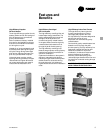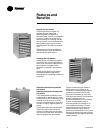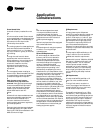
13UH-PRC002-EN
Application
Considerations
(Venting
Unit Heaters)
Venting unit heaters and duct furnaces
used to be as simple as remembering
that warm air rises. With the introduction
of new venting equipment and safety
controls, things have become a little
more technical. Today’s contractor has to
know a lot more about proper venting to
get the job done within code at a
reasonable price.
For starters ANSI now categorizes vented
appliances into four categories. Category
I includes non-condensing appliances
with negative vent pressure, like the
traditional atmospheric unit heater.
Venting Categories
Non-Condensing Condensing
Negative
Vent Pressure I II
Positive
Vent Pressure III IV
Category II groups condensing
appliances with negative vent pressure.
Category III appliances are non-
condensing and operate with a positive
vent pressure, like the traditional power
vented unit heater. Category IV covers
condensing appliances with positive vent
pressure.
Tie smaller units into larger. Avoid cross
connections that feed backwards into
another flue.
Sharing Flues with Other Appliances
Traditionally unit heaters get installed in
pairs, sharing a common flue between
two heaters. When a unit heater must
share a flue with another appliance a few
cautions are appropriate.
Always be certain that the flue can
handle the combined operation of all
appliances connected to it. Never
assume that one appliance will operate
at a time. When connecting into the stack
or breaching always connect the device
with the largest input first. This limits the
potential for flue gases to escape out
other outlets and warms the entire
chimney. Avoid installing appliances
directly across from each other when
entering the stack. This might force the
draft from one appliance to vent out the
opposing draft diverter.
When piping to a stack NEVER reduce
the appliance vent size. Use smooth
transitions and long bends. Abrupt
transitions and tight elbows create
resistance and turbulence that can limit
vent capacity. Never connect power
vented devices to common flues.
Mechanically vented appliances must
have dedicated vents to the point of
termination.
Spill Switch
Problems arise in buildings that have
experienced back drafting from negative
pressure for years. As new units replace
old, the back drafting causes the units to
shutdown, uncovering a makeup air
problem that has gone uncorrected for
years.
Natural Draft Unit Heaters
The gravity vented unit heater still has
the greatest acceptance, but the new
high efficiency of gravity unit heaters add
some new twists to venting. As efficiency
rises more heat gets extracted from the
flue gas. This heat had been driving the
vent system in natural draft systems.
With lower flue gas temperatures,
velocities in the chimney decrease. In
turn this lower velocity can cause flue
gases to reach the point at which they
will condense.
When a factory owner replaces an old
unit heater, having an efficiency of
65 percent, he expects to benefit from
the higher efficiency of the new unit. This
efficiency brings a system change with it
in the form of lower flue temperatures,
closer to the dewpoint.
If the old stack isn’t corrosion resistant
deterioration may be sudden. The mild
acid that forms when vent gas
condenses will gradually eat away at the
metal. Eventually the stack will rust
through leaking fumes and
condensation.
To avoid condensation be certain to use
stacks of the right size. Oversize stacks
draw slower, allowing more time for
condensation. For naturally vented units
use B vent. This insulated vent pipe
contains vent heat, reducing the chances
of condensation. This is particularly
important for vents running through
unheated areas.
In addition to problems from
condensation, contractors have had to
become aware of new mandated
controls. In addition to a high limit
switch, the primary power circuit for
naturally vented atmospheric gas unit
heaters now contains a “spill” switch.
This switch, a manually resettable
thermo disk type device, senses a
blocked flue. Sensitive to a rise in
temperature in the draft diverter, the spill
switch cuts off power to the gas valve
stopping combustion.


















